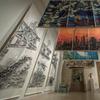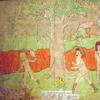'West by Midwest' Exhibition Traces Artists' Westward Migration and Influence
- CHICAGO, Illinois
- /
- September 13, 2018
This fall, the Museum of Contemporary Art Chicago presents West by Midwest, an exhibition tracing how artists with ties to the Midwest helped shape art and culture on the West Coast where they migrated to find career opportunities, art schools, and warmer weather. Spanning the early 1960s to 2010s, works by artists such as Billy Al Bengston, Andrea Bowers, Judy Chicago, Anna Halprin, David Hammons, Mike Kelley, Senga Nengudi, Laura Owens, Sterling Ruby, and Ed Ruscha among many others, demonstrate the ways that contemporary art practices spread and developed across social and geographic lines. West by Midwest presents more than 80 artworks drawn primarily from the MCA Collection and is on view from November 17, 2018 to January 27, 2019. The exhibition is organized by MCA Curatorial Fellow Charlotte Ickes with MCA Chief Curator Michael Darling.
Beginning in the 1950s and 60s, against a backdrop of a new national interstate highway system and the lure of Jack Kerouac and Beat culture, the thriving art schools of California were a powerful draw for young artists. Los Angeles' emerging art scene offered the possibility of creative freedom, experimentation, and collaboration, compared to that of New York, often considered the center of art and culture. Communities of artists, many from the Midwest, found a collaborative spirit that developed into social networks across generations and geographies where they attended school, shared studios, exhibited work, engaged in activism, and developed relationships with one another.
One of the exemplary documents of this migration is Ed Ruscha's iconic artist's book, TWENTYSIX GASOLINE STATIONS (1962). Inspired by Pop Art and the writings of the Beat Generation, Ruscha (from Oklahoma) methodically photographed gas stations along the historic Route 66 from Los Angeles to Oklahoma City, a journey he made back-and-forth numerous times after leaving his home town for California. He assembled 26 neutral, documentary images into an artist book with no text entitled TWENTYSIX GASOLINE STATIONS.
Artists Billy Al Bengston (from Kansas) and Judy Chicago (from Illinois) met in in Los Angeles where both were fascinated by the use of new materials, such as spray paints, plastics, and lacquer, and other techniques that became central to the emerging Finish Fetish movement. Blending the aesthetics of Pop Art, Minimalism, and Light and Space, Finish Fetish featured glossy, slick finishes that recalled staples of Southern California culture such as automobiles, motorcycles, and surfboards.
In the early 1970s, Judy Chicago brought the Feminist Art Program she founded at Fresno State College to the newly formed California Institute of the Arts (CalArts) with fellow artist Miriam Schapiro (studied in Iowa) producing an alternative method of consciousness-raising and collaboration. Prior to that, Schapiro had collaborated with a physicist in San Diego on computer-aided drawings that would be used for her hard-edged paintings. In her work Computer Series she combined technology with geometric minimalism where the strict lines of interlocking squares rested against a background of atmospheric color, characteristic of much Southern California art in the 1960s.
David Hammons began making his famous body prints in the late 1960s after moving from his hometown of Springfield, Illinois to study art in Los Angeles. The artist would grease his skin with margarine, press his body onto the paper, and add a coat of powdered pigment to the surface of the print. In this unorthodox self-portrait, Hammons meditates on how stereotypes flatten the self.
The urban landscape of LA also served as a site of improvisation, performance, and collaboration for artists involved in Studio Z, a loose collective of African-American artists that included Hammons and Senga Nengudi (also from Illinois). Nengudi's Ceremony for Freeway Fets is one example of their collaboration, this one involving a performance under a freeway overpass that was subject to protest by communities of color whose neighborhoods were under threat by the expansion of the city's freeway system.
Jim Shaw and Mike Kelley started the band and collective Destroy All Monsters while attending the University of Michigan, and later moved to the West Coast as graduate students at CalArts. The exhibition features Kelley's large-scale installation, Craft Morphology Flow Chart, which consists of crocheted dolls and sock monkeys arranged on tables, recalling the display of specimens in a natural history museum as commentary on the museum's role in collection and preservation. Kelley went on to teach another generation of artists with Midwestern affiliations, such as Jorge Pardo (born in Chicago), Sterling Ruby (from Michigan), and Aaron Curry (studied in Chicago), who once shared studio space in East LA with friend and former Chicago artist Amanda Ross-Ho (born in Chicago).
The exhibition is accompanied by an extensive microsite that expands on the themes of exhibition at: www.mcachicago.org/west-by-midwest.






![Peter Paul Rubens (Flemish, 1577–1640), After Titian (Tiziano Vecelli) (Italian [Venetian], c. 1488–1576), Rape of Europa, 1628–29. Oil on canvas, 71 7/8 x 79 3/8 in. Peter Paul Rubens (Flemish, 1577–1640), After Titian (Tiziano Vecelli) (Italian [Venetian], c. 1488–1576), Rape of Europa, 1628–29. Oil on canvas, 71 7/8 x 79 3/8 in.](/images/c/e2/2e/Jan20_Rape_of_Europa100x100_c.jpg)

100x100_c.jpg)







